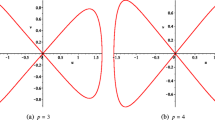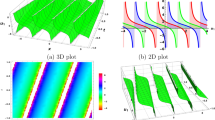Abstract
The modified Gardner equation is widely used to describe the supernonlinear proliferation of ion-acoustic waves and quantum electron-positron ion magneto plasmas. This paper focuses on the investigation of the modified Gardner equation with Kuramoto-Sivashinsky perturbation. The existence results of nonlinear and supernonlinear ion-acoustic solitary and periodic waves are established by employing the geometric singular perturbation theory, invariant manifold theory, and bifurcation theory. The supernonlinear solitary wave is a new class of solitary waves, which was proposed by Dubinov and Kolotkov [12]. In this work, the existence of the novel type of ion-acoustic solitary and periodic waves in the perturbed modified Gardner equation has been proven for the first time. Through rigorous mathematical analysis and numerical simulations, we further substantiate the validity of our proposed methods and model. Overall, this study enhances the understanding of the nonlinear and supernonlinear dynamics of ion-acoustic waves in the modified Gardner equation, while also providing a solid foundation for future investigations and applications in plasma physics and related disciplines.









Similar content being viewed by others
Data Availability
This manuscript has no associated data.
References
Debnath, L.: Nonlinear Partial Differential Equations for Scientists and Engineers, Birkhäuser Boston, (2005)
Gintautas, V., Hubler, A.W.: Resonant forcing of nonlinear systems of differential equations. Chaos 18, 033118 (2008)
Wazwaz, A.M.: Partial Differential Equations and Solitary Waves Theory. Springer, Berlin, Heidelberg (2010)
Seadawy, A.R.: Stability analysis for Zakharov-Kuznetsov equation of weakly nonlinear ion-acoustic waves in a plasma. Comput. Math. Appl. 67, 172–180 (2014)
Seadawy, A.R., Iqbal, M., Lu, D.: Applications of propagation of long-wave with dissipation and dispersion in nonlinear media via solitary wave solutions of generalized Kadomtsev-Petviashvili modified equal width dynamical equation. Comput. Math. Appl. 78, 3620–3632 (2019)
Rizvi, S.T.R., Seadawy, A.R., Ahmed, S., Younis, M., Ali, K.: Study of multiple lump and rogue waves to the generalized unstable space time fractional nonlinear Schrödinger equation. Chaos Solitons Fractals 151, 111251 (2021)
Roshid, H.-O., Roshid, M., Abdeljabbar, A., Begum, M., Basher, H.: Abundant dynamical solitary waves through Kelvin-Voigt fluid via the truncated M-fractional Oskolkov model. Results Phys. 55, 107128 (2023)
Ullah, M.S., Baleanu, D., Ali, M.Z., Roshid, H.-O.: Novel dynamics of the Zoomeron model via different analytical methods. Chaos Solitons Fractals 174, 113856 (2023)
Alshammari, F.S., Roshid, H.-O., Asif, M., Hoque, M.F., Aldurayhim, A.: Bifurcation analysis on ion sound and Langmuir solitary waves solutions to the stochastic models with multiplicative noises. Heliyon 9, e16570 (2023)
Hossain, M.M., Abdeljabbar, A., Roshid, H.-O., Roshid, M.M., Sheikh, A.N.: Abundant bounded and unbounded solitary, periodic, rogue-type wave solutions and analysis of parametric effect on the solutions to nonlinear klein-gordon model. Complexity 2022, 1–19 (2022)
Busse, F.H.: Non-linear properties of thermal convection. Rep. Progr. Phys. 41, 1929–1967 (1978)
Dubinov, A.E., Kolotkov, DYu.: Ion-acoustic supersolitons in plasma. Plasma Phys. Rep. 38, 909–912 (2012)
Derks, G., Gils, S.: On the uniqueness of traveling waves in perturbed Korteweg-de Vries equations, Japan J. Indust. Appl. Math. 10, 413–430 (1993)
Ogawa, T.: Traveling wave solutions to a perturbed Korteweg-de Vries equation. Hiroshima Math. J. 24, 401–422 (1994)
Topper, J., Kawahara, T.: Approximate equations for long nonlinear waves on a viscous fluid. J. Phys. Soc. Japan 44, 663–666 (1978)
Li, W.-T., Lin, G., Ruan, S.: Existence of travelling wave solutions in delayed reactiondiffusion systems with applications to diffusion-competition systems. Nonlinearity 19, 1253–1273 (2006)
Ma, S.: Traveling wavefronts for delayed reaction-diffusion systems via a fixed point theorem. J. Differ. Equ. 171, 294–314 (2001)
Zhang, T., Wang, W., Wang, K.: Minimal wave speed for a class of non-cooperative diffusionreaction system. J. Differ. Equ. 260, 2763–2791 (2016)
Gardner, R., Smoller, J.: The existence of periodic travelling waves for singularly perturbed predator-prey equations via the Conley index. J. Differ. Equ. 47, 133–161 (1983)
Huang, W.: A geometric approach in the study of traveling waves for some classes of nonmonotone reaction-diffusion systems. J. Differ. Equ. 260, 2190–2224 (2016)
Wu, J., Zou, X.: Traveling wave fronts of reaction-diffusion systems with delay. J. Dynam. Differ. Equ. 13, 651–687 (2001)
Fenichel, N.: Geometric singular perturbation theory for ordinary differential equations. J. Differ. Equ. 31, 53–98 (1979)
Broer, H.W., Kaper, T.J., Krupa, M.: Geometric desingularization of a cusp singularity in slow-fast systems with applications to Zeeman’s examples. J. Dynam. Differ. Equ. 25, 925–958 (2013)
Jardón-Kojakhmetov, H., Broer, H. W.: Polynomial normal forms of constrained differential equations with three parameters, J. Differential Equations 257 (2014) 1012-1055
Krupa, M., Szmolyan, P.: Extending geometric singular perturbation theory to nonhyperbolic points - fold and canard points in two dimensions. SIAM J. Math. Anal. 33, 286–314 (2001)
Krupa, M., Szmolyan, P.: Relaxation oscillation and canard explosion. J. Differ. Equ. 174, 312–368 (2001)
Lu, N., Zeng, C.: Normally elliptic singular perturbations and persistence of homoclinic orbits. J. Differ. Equ. 250, 4124–4176 (2011)
Schecter, S.: Exchange lemmas 2: general exchange lemma. J. Differ. Equ. 245, 411–441 (2007)
Jones, C.K.R.T.: Geometrical Singular Perturbation Theory. Lecture Notes in Mathematics, pp. 44–118. Springer, New York (1995)
Robinson, C.: Sustained resonance for a nonlinear system with slowly varying coefficients. SIAM J. Math. Anal. 14, 847–860 (2006)
Chen, A., Guo, L., Huang, W.: Existence of kink waves and periodic waves for a perturbed defocusing mKdV equation. Qual. Theory Dyn. Syst. 17, 495–517 (2018)
Chen, A., Zhang, C., Huang, W.: Monotonicity of limit wave speed of traveling wave solutions for a perturbed generalized KdV equation. Appl. Math. Lett. 121, 107381 (2021)
Li, H., Sun, H., Zhu, W.: Solitary waves and periodic waves in a perturbed KdV equation. Qual. Theory Dyn. Syst. 19, 83 (2020)
Cheng, F., Li, J.: Geometric singular perturbation analysis of Degasperis-Procesi equation with distributed delay. Discrete Contin. Dyn. Syst. 41, 967–985 (2021)
Xu, G., Zhang, Y.: On the existence of solitary wave solutions for perturbed Degasperis-Procesi equation. Qual. Theory Dyn. Syst. 20, 1–10 (2021)
Du, Z., Li, J.: Geometric singular perturbation analysis to Camassa-Holm Kuramoto-Sivashinsky equation. J. Differ. Equ. 306, 418–438 (2022)
Du, Z., Li, J., Li, X.: The existence of solitary wave solutions of delayed Camassa-Holm equation via a geometric approach. J. Funct. Anal. 275, 988–1007 (2018)
Qiu, H., Zhong, L., Shen, J.: Traveling waves in a generalized Camassa-Holm equation involving dual-power law nonlinearities. Commun. Nonlinear Sci. Numer. Simul. 106, 106106 (2022)
Chen, A., Guo, L., Deng, X.: Existence of solitary waves and periodic waves for a perturbed generalized BBM equation. J. Differ. Equ. 261, 5324–5349 (2016)
Guo, L., Zhao, Y.: Existence of periodic waves for a perturbed quintic BBM equation. Discrete Contin. Dyn. Syst. 40, 4689–4703 (2020)
Sun, X., Yu, P.: Periodic traveling waves in a generalized BBM equation with weak backward diffusion and dissipation terms. Discrete Contin. Dyn. Syst. Ser. B 24, 965–987 (2018)
Du, Z., Qiao, Q.: The dynamics of traveling waves for a nonlinear Belousov-Zhabotinskii system. J. Differ. Equ. 269, 7214–7230 (2020)
Du, Z., Liu, J., Ren, Y.: Traveling pulse solutions of a generalized Keller-Segel system with small cell diffusion via a geometric approach. J. Differ. Equ. 270, 1019–1042 (2021)
Tang, Y., Xu, W., Shen, J., Gao, L.: Persistence of solitary wave solutions of singularly perturbed Gardner equation. Chaos Solitons Fractals 37, 532–538 (2008)
Wen, Z.: On existence of kink and antikink wave solutions of singularly perturbed Gardner equation. Math. Methods Appl. Sci. 43, 4422–4427 (2020)
Betchewe, G., Victor, K.K., Thomas, B.B., Crepin, K.T.: New solutions of the Gardner equation: Analytical and numerical analysis of its dynamical understanding. Appl. Math. Comput. 223, 377–388 (2013)
Fu, Z., Liu, S., Liu, S.: New kinds of solutions to Gardner equation. Chaos Solitons Fractals 20, 301–309 (2004)
Wang, K.: Traveling wave solutions of the Gardner equation in dusty plasmas. Results Phys. 33, 105207 (2022)
Olivier, C.P., Verheest, F., Hereman, W.A.: Collision properties of overtaking supersolitons with small amplitudes. Phys. Plasmas 25, 032309 (2018)
Tamang, J., Saha, A.: Bifurcations of small-amplitude supernonlinear waves of the mKdV and modified Gardner equations in a three-component electron-ion plasma. Phys. Plasmas 27, 012105 (2020)
Jhangeer, A., Hussain, A., Junaid-U-Rehman, M., Baleanu, D., Riaz, M.B.: Quasi-periodic, chaotic and traveling wave structures of modified Gardner equation. Chaos Solitons Fractals 143, 110578 (2021)
Szmolyan, P.: Transversal heteroclinic and homoclinic orbits in singular perturbation problems. J. Differ. Equ. 92, 252–281 (1991)
Carr, J.: Applications of the Center Manifold Theory. Springer-Verlag, New York (1981)
Fan, S.: A new extracting formula and a new distinguished means on the one valuable cubic equation. Natural Sci. J. Hainan Teach. College 2, 91–98 (1989)
Funding
This work is suppoeted by the Beijing Natural Science Foundation (Grant No. 1232015), Education and teaching reform project of Beijing University of Posts and Telecommunications (Grant No. 2022SZ-A16), Beijing University of Post and Telecommunications Graduate education and teaching reform and research (Grant No. 2022Y026).
Author information
Authors and Affiliations
Contributions
YQ wrote the main manuscript text and prepared figures. YT and YJ helped perform the analysis with constructive discussions. All authors reviewed the manuscript.
Corresponding author
Ethics declarations
Conflict of Interest
The author(s) declared no potential conflicts of interest with respect to the research, authorship, and publication of this article.
Ethical Approval
Ethical Approval is not applicable to this article, as no human or animal studies exist.
Additional information
Publisher's Note
Springer Nature remains neutral with regard to jurisdictional claims in published maps and institutional affiliations.
Appendix A: Discriminant of the Roots of a Cubic Equation
Appendix A: Discriminant of the Roots of a Cubic Equation
Lemma A.1
[54] For a cubic equation with one unknown
the discriminant is
where
we have
-
(1)
if \( M=N=0 \), the Eq. (A.1) has a triple real root;
-
(2)
if \(\Delta >0\), the Eq. (A.1) has one real root and a pair of conjugate imaginary roots;
-
(3)
if \(\Delta =0\), the Eq. (A.1) has three real roots, one of which is a dual root;
-
(4)
if \(\Delta <0\), the Eq. (A.1) has three distinct real roots.
Rights and permissions
Springer Nature or its licensor (e.g. a society or other partner) holds exclusive rights to this article under a publishing agreement with the author(s) or other rightsholder(s); author self-archiving of the accepted manuscript version of this article is solely governed by the terms of such publishing agreement and applicable law.
About this article
Cite this article
Qi, Y., Tian, Y. & Jiang, Y. Existence of Traveling Wave Solutions for the Perturbed Modefied Gardner Equation. Qual. Theory Dyn. Syst. 23, 106 (2024). https://doi.org/10.1007/s12346-024-00960-x
Received:
Accepted:
Published:
DOI: https://doi.org/10.1007/s12346-024-00960-x
Keywords
- Geometric singular perturbation theory
- Bifurcation theory
- Modified gardner equation
- Traveling waves solution
- Invariant manifold theory




